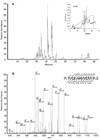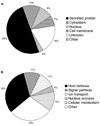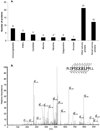Proteome of human minor salivary gland secretion
- PMID: 18434574
- PMCID: PMC2857507
- DOI: 10.1177/154405910808700508
Proteome of human minor salivary gland secretion
Abstract
Recent research efforts in oral biology have resulted in elucidation of the proteomes of major human salivary secretions and whole saliva. One might hypothesize that the proteome of minor gland secretions may show significantly different characteristics when compared with the proteomes of parotid or submandibular/sublingual secretions. To test this hypothesis, we conducted the first exploration into the proteome of minor salivary gland secretion. Minor gland secretion was obtained from healthy volunteers, and its components were subjected to liquid-chromatography-electrospray-ionization-tandem-mass-spectrometry. This led to the identification of 56 proteins, 12 of which had never been identified in any salivary secretion. The unique characteristics of the minor salivary gland secretion proteome are related to the types as well as the numbers of components present. The differences between salivary proteomes may be important with respect to specific oral functions.
Figures




References
-
- Baum BJ, Bird JL, Millar DB, Longton RW. Studies on histidine-rich polypeptides from human parotid saliva. Arch Biochem Biophys. 1976;177:427–436. - PubMed
-
- Bruno LS, Li X, Wang L, Soares RV, Siqueira CC, Oppenheim FG, et al. Two-hybrid analysis of human salivary mucin MUC7 interactions. Biochim Biophys Acta. 2005;1746:65–72. - PubMed
-
- Crawford JM, Taubman MA, Smith DJ. Minor salivary glands as a major source of secretory immunoglobin A in the human oral cavity. Science. 1975;190:1206–1209. - PubMed
-
- Dawes C, Wood CM. The contribution of oral minor mucous gland secretions to the volume of whole saliva in man. Arch Oral Biol. 1973;18:337–342. - PubMed
Publication types
MeSH terms
Substances
Grants and funding
LinkOut - more resources
Full Text Sources

